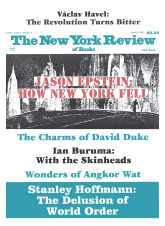In response to:
Ghosts of Pearl Harbor from the December 19, 1991 issue
To the Editors:
It is a little difficult to tell from Mr. Ian Baruma’s interesting review of my book, Betrayal at Pearl Harbor [NYR, December 19, 1991], how much he understands about cryptography. However, if he had studied the extensive paper trail of evidence in the book, I believe he would have had no difficulty in accepting that British codebreakers (in London and Singapore) had broken the new Japanese naval code (JN-25) by the fall of 1939.
This is, incidentally, confirmed on page 53 of Professor F.H. Hinsley’s British Intelligence in the Second World War (Cambridge University Press, 1979), which states that the new code “began to yield” in September 1939, and thereafter British cryptographers were able to keep track of the main Japanese naval movements.
We also know that the messages from Admiral Yamamoto to his Carrier Task Force were decrypted by the British and received in London, because I quote (on page 137) from an Admiralty signal confirming this. The message of 25 November, 1941, ordering the Task Force to sail and refuel eight days later out in the Pacific, was of such crucial importance that it is impossible to believe it was not shown at once to Churchill who saw all such messages in the raw (original) state even before his military commanders.
Even though there was no mention of the Task Force’s ultimate destination, it hardly required a navigational genius to conclude that Pearl Harbor was one of the most likely targets and, therefore, one would have expected Churchill to have flashed this message immediately to Roosevelt so that the two leaders could then debate its implications.
Had Churchill done this, I believe Roosevelt would have immediately alerted his Hawaiian commanders to set a trap for the Japanese, and thus gone to war as a victor decimating the Task Force and possibly blunting Japan’s strategic plans entirely. The fact he made no attempt to do this either means Roosevelt deliberately betrayed the United States, or he was not passed the information, in which case Churchill betrayed Roosevelt.
Since my book was published, I have received a statement from an old family friend of the late Commander Malcolm Burnett (Nave’s codebreaking colleague) who, in 1980, admitted that he had decrypted all Yamamoto’s signals to the Task Force, had guessed their destination was Pearl Harbor, and personally sent this back from Singapore to Churchill. Burnett was pressed to write this down for posterity, but refused to do so because he had been sworn to secrecy about the affair.
James Rusbridger
Cornwall, England
Ian Buruma replies:
Mr. Rusbridger is right to doubt my expertise in cryptography: it is virtually nil. I take his word for it that the message from Admiral Yamamoto in November 1941 was read by British code breakers and that “it is impossible to believe it was not shown at once to Churchill….” But this doesn’t prove a conspiracy to trap Roosevelt into going to war.
Heaps of intelligence passed across Churchill’s desk, some genuine, some false. Although it is easy after the event to see bad faith or plain lunacy in the failure to act on such data, this is not necessarily the right interpretation. Stalin had prior warning of Hitler’s plan to attack the Soviet Union and did nothing. MacArthur knew that the Japanese had attacked Pearl Harbor and would almost certainly attack the Philippines, but failed to act. As a historian, quoted by Mr. Rusbridger in his book, remarked about Pearl Harbor, important signals can be “partly obscured before the event by the surrounding noise.” Or they can be disbelieved. So even if Churchill had been warned that Pearl Harbor was a possible target for a Japanese attack, his failure to tell Roosevelt might have been a betrayal, but then again it might not.
And one other thing, for an eagle-eyed decoder of complicated data, Mr. Rusbridger might have spelled my name right.
This Issue
April 9, 1992



